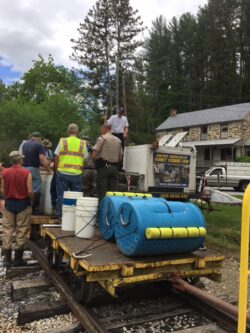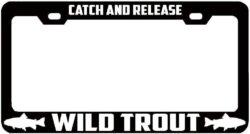There is an ongoing debate with fly fishermen about catching “Wild” or “Stocked” trout. Stocked trout are taboo! Fishing for stocked trout is a sin. Maybe we need to decide upon the difference between ‘Wild” and ‘Stocked” trout. How are these fish different from “Native” trout.
“Hatchery raised fish are inferior, lousy to eat, have no energy, lack natural beauty, and invade Wild trout waters.” The truth is that Hatchery trout are often stronger, healthier, and bigger than Wild trout, of the same age. They also tend to be more durable when caught and released. Many stocked fish are also more tolerant of diseases.
In Montana, many of the cutthroat trout eggs are from “Wild “trout. In fact, Yellowstone Cutthroats and many rainbow trout eggs used in Federal hatcheries, come from Wild Stock in Ennis, Montana, or Yellowstone Park. Many of the “Wild “brook trout, in eastern states, are originally from stocked fish from New Jersey Hatcheries based on their wild DNA tested stock.
Hatchery trout must pass all health and consumption tests. They need to be disease free, have no toxins or contaminants, and be healthy to eat. Some over fished/ popular waters can’t support a wild trout fishery and rely upon stocking.
Some waters never had fish, let alone trout. Without stocking, they would be devoid of fish. Yellowstone Park is a good example. Most of the national park’s waters were fishless until stocked. Today Yellowstone Park is not stocked and is a cherished fishermen’s destination to catch Wild trout.
Wild trout often have contaminants in them due to environmental conditions. Most “Wild” trout in Montana have consumption warnings. Every watershed that starts in Yellowstone Park contains mercury, lead, arsenic, and other natural pollutants that come from geothermal waters. This doesn’t consider the mining, sewage, and other pollutants also in most Big Sky waters.
Most Wild trout are the result of hatchery stocking survivors. Stocked fish can end up reproducing in wild waters. Montana’s ‘Wild” rainbow, browns, brooks, lakers, Kokanee, and walleyes, in Montana, are all the result of being stocked. Many were stocked in non-native waters. They now reproduce naturally and are considered Wild trout.
Native trout were there first. “Native” trout in North America means Brook trout in the east, Rainbows/ salmon in the west, and Cutthroats in the middle. These populations evolved and survived on their own, prior to humans and hatcheries. With time, some of these species have evolved into more modern species. Others have become threatened or extinct.
Survival of the fittest is important. Over 20 species of just Rainbow trout have been stocked in the Madison River of Montana. Only some have thrived to become “Wild” trout. This fishery is no longer stocked. It’s great to not stock fish where fish can thrive on their own. Sadly, these places are fewer and further in between. They are also often overfished, like the Madison River.
Many cold-water release fisheries are the result of Dams. The Bighorn River in Montana never had trout in it until the Yellowtail Dam was built. Cold water could then be released year around. The water was cold but low in oxygen, so they built a second dam to form an afterbay that is used to allow oxygen to return. Trout are stocked in the afterbay and then escape into the river to create this world class” wild” trout fishery.
Our waters are simply not the same as they were long ago. Development, weather, drought, dams, and so many other factors have made fisheries different. Is it best to manage them as “Wild” or as simply “Trout’ Fisheries?
“Wild “trout fisheries may not be “Native” fisheries. Fish that live in the Wild and naturally reproduce are not Native. A Native fish is one that historically evolved and lived in a watershed. Evolution and environments result in change. Grayling, a close relative of trout, are Native to more ice age conditions. Since many watersheds have changed with the withdrawal of glaciers, they do not survive in once Native waters.
Stocked trout can out compete wild or native fish. They can interbreed, prey on others, and destroy Native populations. Therefore, management becomes important. Native Brook trout populations need special protections due to this issue.
We can cast dismay onto all trout fisheries in some way or another. In the end, we fish to catch fish. You can choose to release them back into the water or a frying pan, if legal. Fishing is supposed to be fun! That means catching fish is part of the process. Eating fish may also be a part of the process.
We can manage fisheries for many purposes. Waters that warm up in the Summer may be wonderful for the rest of the year. These areas can be managed as Delayed Harvest or Put and Take. Local ponds and community waters can be perfect for seasonal stocking programs.
Fish can be Caught and Released, with proper technique. This allows fish to be caught many times. At some point the stress can be fatal. Overfishing can lead to high mortality. Currently, the Madison River is a perfect example of an overfished Wild Trout water.
We can manage for Trophy Waters. Slot limits may promote certain sized fish to be harvested while maintaining natural reproduction. Endangered species may need protections that include no fishing.
Artificial Lures only can limit the ways fish are caught. Some areas only permit fly fishing, fishing only from shore, fishing only from a boat, no anchoring in a boat, fishermen must keep all fish that they catch and pay for them, kill, and report every fish caught, use single hooks only, and many other options.
Ponds and streams can be managed for Seniors, handicapped, and kid fisheries. Supplementing with stocked fish gets everyone hooked on fishing.
Everyone can have their fishing needs met. Not everyone eats fish, uses bait, uses flies, uses lures, uses a boat, uses a cane pole, or has some other preference. To each his own but respect everyone’s right to celebrate our sport. There is a legal something for everyone.
There is a menu of options that can invite all anglers to be respectful, ethical, sportsmen. Trout fishing is not about “there can be only one!”
Sport Fishing is about having fun! If you are not enjoying the sport, you are doing it wrong. Catching a fish is the goal. The more folks that fish, the more positive votes there are for future fishing, management, and watershed protections.
Get hooked on fishing and help to protect and conserve our fisheries for the future.
Montana Grant